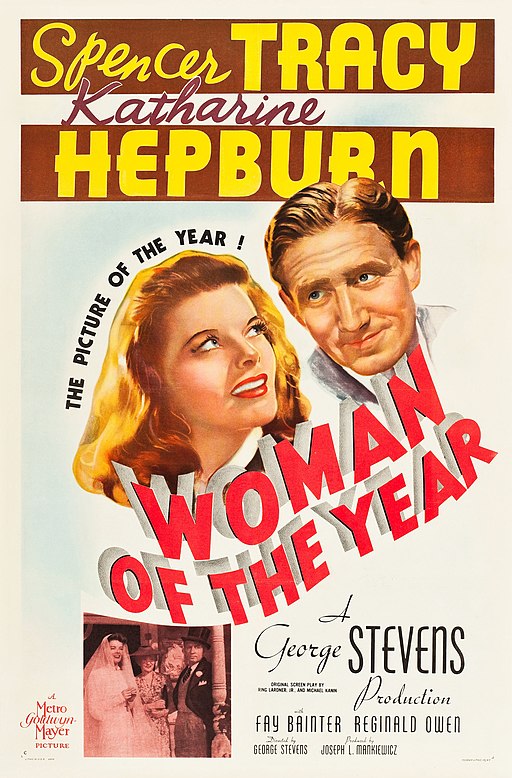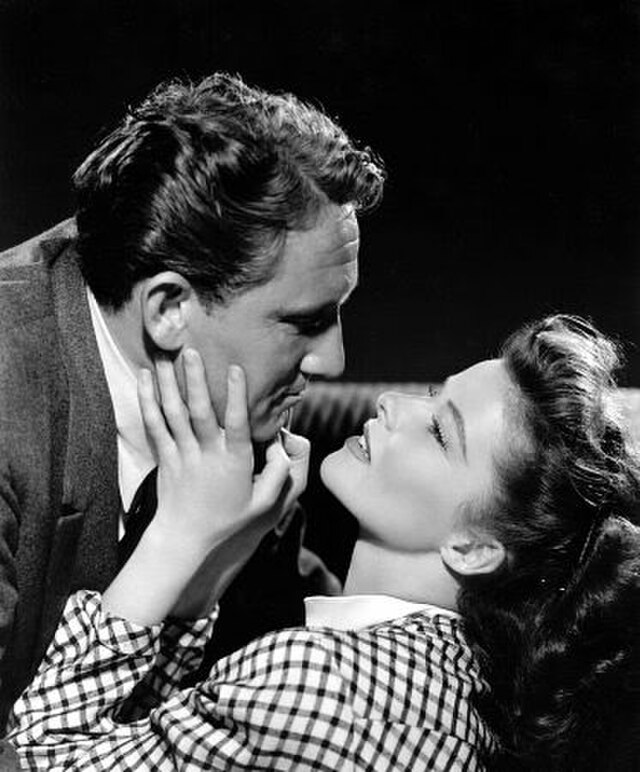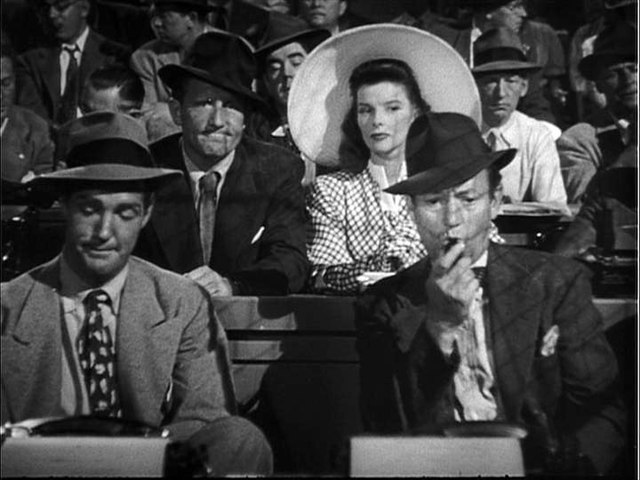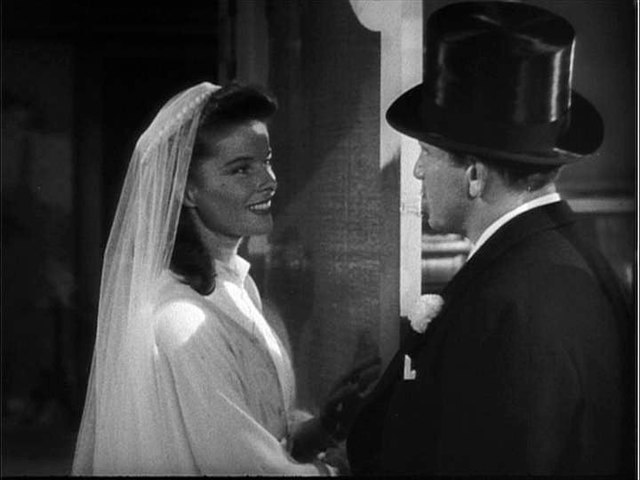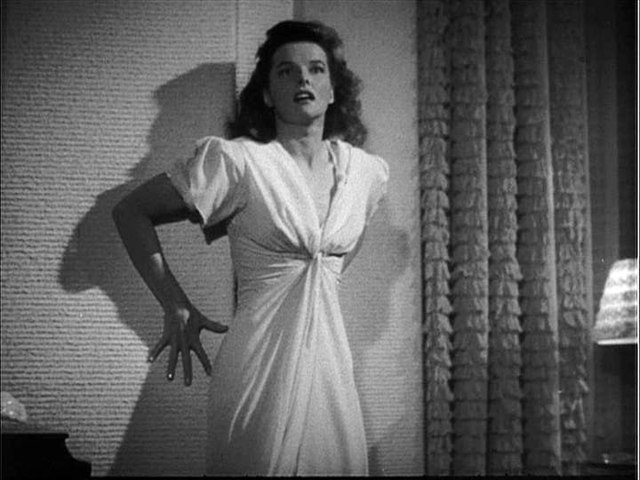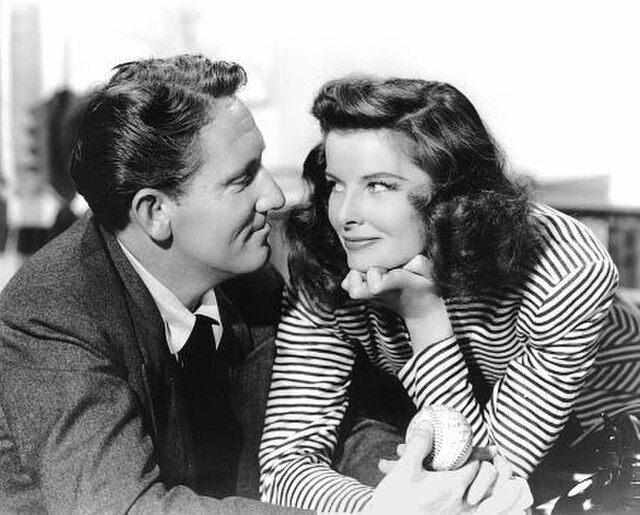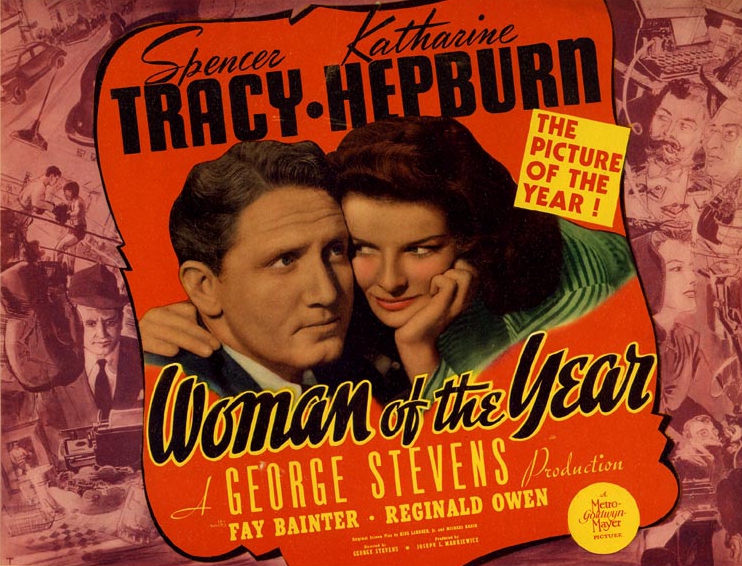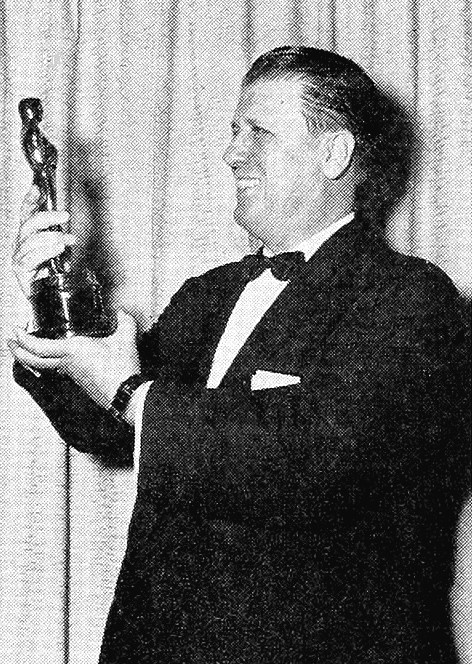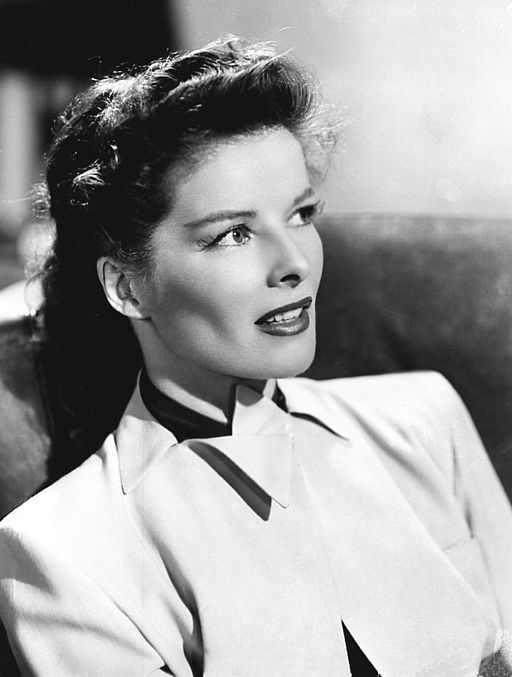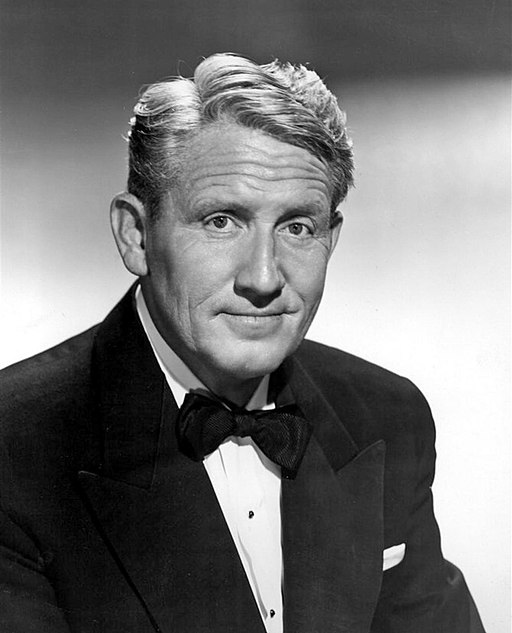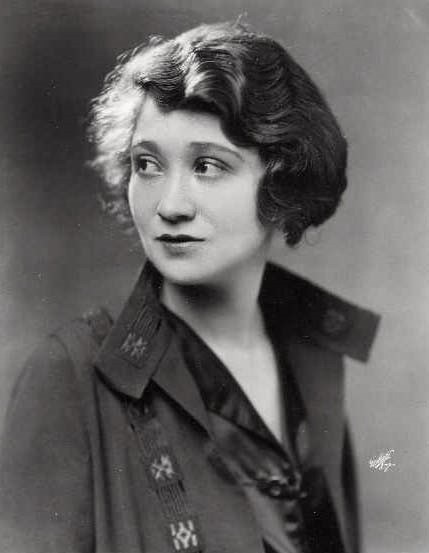Woman of the Year - 1942
back| Released by | Metro-Goldwyn-Mayer |
| Director | George Stevens |
| Producer | Joseph L. Mankiewicz |
| Script | Ring Lardner Jr. and Michael Kanin |
| Cinematography | Joseph Ruttenberg |
| Music by | Franz Waxman |
| Running time | 114 minutes |
| Film budget | $941,000 |
| Box office sales | $2.7 million |
| Main cast | Spencer Tracy - Katharine Hepburn - Fay Bainter - Reginald Owen |
Woman of the Year
The First Tracy & Hepburn Hit
"Woman of the Year" (1942), directed by George Stevens, stars Spencer Tracy and Katharine Hepburn in their first on-screen pairing.
The film follows the romance and marriage of Sam Craig, a sportswriter, and Tess Harding, an accomplished political columnist. Their relationship is tested by Tess's demanding career and Sam's desire for a traditional domestic life.
The movie expertly balances comedy and drama, highlighting the challenges of balancing professional ambition with personal relationships.
Related
Woman of the Year – 1942
Summary and Analysis
"Woman of the Year" is a classic romantic comedy that captures the tension and eventual harmony between two strong-willed characters from vastly different worlds. Directed by George Stevens, the film begins with Sam Craig (Spencer Tracy), a down-to-earth sportswriter for a New York newspaper, and Tess Harding (Katharine Hepburn), an internationally renowned political columnist for the same paper. Their paths cross when Sam takes offense to Tess's dismissive comment about sports being a trivial pursuit, leading to a public argument through their columns.
Intrigued by each other’s boldness, Sam and Tess agree to meet in person. Despite their differences, they find themselves attracted to one another. Their romance quickly blossoms, and they decide to marry. However, post-marriage life reveals the vast gap between their lifestyles and expectations. Tess's busy, high-profile career and her passion for global issues clash with Sam's simpler, more grounded approach to life.
Tess's career often takes precedence over her personal life, leading to conflicts and misunderstandings. The couple's differences are highlighted in several key scenes, such as Tess's inability to comprehend Sam's love for sports and her failure to fulfill domestic roles. The tension reaches a peak when Tess adopts a Greek refugee child without consulting Sam, expecting him to be as excited about the decision as she is.
Sam, feeling increasingly marginalized in their marriage, decides to leave Tess. In a dramatic turn, Tess realizes that her career-driven lifestyle has been at the expense of her personal happiness and her relationship with Sam. She decides to win him back by embracing domesticity. This leads to the film's iconic scene where Tess attempts to make breakfast for Sam in a hilariously disastrous fashion, showcasing her unfamiliarity with household tasks.
In the end, Tess's genuine effort to reconcile and Sam's realization that they can find a middle ground bring them back together. They both agree to compromise and balance their careers with their relationship, symbolizing the film’s broader theme of the possibility of harmony between personal and professional life.
Analysis:
"Woman of the Year" serves as both a romantic comedy and a social commentary on gender roles and career dynamics in the early 1940s. The film explores the evolving role of women in the workplace, highlighting the tension between professional ambition and traditional domestic expectations.
Character Dynamics:
- Tess Harding: Katharine Hepburn's portrayal of Tess is a blend of sophistication, intelligence, and independence. Tess is a trailblazer in her professional life but struggles to navigate the traditional expectations of marriage. Her character embodies the challenges faced by many career-oriented women of the era.
- Sam Craig: Spencer Tracy's Sam is the epitome of the everyman—grounded, practical, and a bit old-fashioned. His character provides a counterpoint to Tess, representing the societal norms that valued traditional gender roles.
Themes:
- Gender Roles and Equality: The film tackles the issue of gender roles head-on. Tess’s success and independence challenge the traditional views of a woman's place in society, creating friction in her marriage with Sam, who initially expects her to conform to a more conventional role.
- Compromise and Balance: The resolution of the film suggests that successful relationships require compromise and mutual respect. Both Tess and Sam must adjust their expectations and find a middle ground to make their marriage work.
- Personal vs. Professional Life: "Woman of the Year" delves into the difficulties of balancing a demanding career with personal relationships. Tess's journey highlights the sacrifices and adjustments needed to maintain both.
Cinematic Elements:
- Direction and Cinematography: George Stevens’s direction ensures a seamless blend of comedy and drama, capturing the nuanced performances of Tracy and Hepburn. Joseph Ruttenberg’s cinematography complements the narrative, with dynamic shots that enhance both the romantic and comedic elements.
- Script and Dialogue: The witty and sharp dialogue, penned by Ring Lardner Jr. and Michael Kanin, is one of the film’s standout features. The verbal sparring between Tess and Sam is both entertaining and revealing of their characters’ complexities.
- Music: Franz Waxman’s musical score underscores the film’s emotional beats, enhancing both the comedic and poignant moments.
Cultural Impact: "Woman of the Year" marked the beginning of the legendary on-screen partnership between Hepburn and Tracy, who went on to make nine films together. The film’s exploration of gender roles and career dynamics remains relevant, reflecting ongoing societal discussions about work-life balance and the evolving roles of women.
In conclusion, "Woman of the Year" is a timeless film that combines romance, comedy, and social commentary. Its engaging story, memorable performances, and thought-provoking themes make it a significant work in the canon of classic Hollywood cinema.
"Woman of the Year" is a romantic comedy that explores the dynamics between a sportswriter and a political columnist as they navigate their careers and relationship. The film is notable for being the first pairing of Spencer Tracy and Katharine Hepburn, a duo that would become one of Hollywood's most beloved on-screen couples.
Trailer "Woman of the Year":
Full Cast of “Woman of the Year”:
- Spencer Tracy as Sam Craig
- Katharine Hepburn as Tess Harding
- Fay Bainter as Ellen Whitcomb
- Reginald Owen as Clayton
- Minor Watson as William Harding
- William Bendix as Pinkie Peters
- Gladys Blake as Flo Peters
- Dan Tobin as Gerald Howe
- Roscoe Karns as Phil Whittaker
- William Tannen as Ellis
- Ludwig Stössel as Dr. Lubbeck
- Edith Evanson as Alma
- George Kezas as Chris (Greek Boy)
- Charles Arnt as Radio announcer
- Sara Haden as Matron in charge of the orphanage
Masterful Direction of George Stevens:
George Stevens' direction in "Woman of the Year" is a masterful blend of sharp wit, emotional depth, and visual storytelling. Stevens, known for his versatility across different genres, brings a unique sensitivity to this romantic comedy, making it more than just a light-hearted film. His ability to balance humor with serious themes sets this film apart as a nuanced and engaging narrative.
Character-Driven Storytelling:
Stevens' strength lies in his character-driven approach. He focuses intently on the development of Tess Harding and Sam Craig, played by Katharine Hepburn and Spencer Tracy. By giving ample screen time to their interactions and personal growth, Stevens ensures that the audience becomes deeply invested in their journey. His direction allows the characters to evolve naturally, showcasing their complexities and making their relationship believable and relatable.
Performance Direction:
One of Stevens' key achievements in "Woman of the Year" is his handling of the actors' performances. Under his direction, both Hepburn and Tracy deliver some of their finest work. Stevens has a keen eye for subtlety and nuance, which is evident in the way he captures the chemistry between the leads. He allows the actors to explore their characters' vulnerabilities and strengths, resulting in performances that are both powerful and understated.
Balancing Comedy and Drama:
Stevens expertly navigates the balance between comedy and drama in the film. He understands that the humor in "Woman of the Year" comes from genuine character moments rather than forced jokes. Scenes like Tess's disastrous attempt at cooking breakfast are funny not just because of the slapstick elements but because they highlight Tess's earnest, if misguided, efforts to adapt to a new role. This blend of humor with an underlying emotional truth is a hallmark of Stevens' direction.
Visual Composition:
The visual composition in "Woman of the Year" is another testament to Stevens' directorial prowess. He uses framing and camera movements to enhance the storytelling. For instance, his use of close-ups during the more intimate scenes between Tess and Sam draws the audience into their world, making their emotions palpable. The contrast between the bustling, chaotic newsroom and the more serene domestic settings visually underscores the tension between Tess's professional and personal lives.
Pacing and Rhythm:
Stevens' control over the film's pacing ensures that it maintains a rhythm that keeps the audience engaged throughout. He deftly handles the transitions between the various tones of the film, from the lively banter and public spats to the quieter, more reflective moments. This careful modulation of pace allows the story to breathe and the characters to unfold naturally.
Attention to Detail:
Another notable aspect of Stevens' direction is his attention to detail. Whether it’s the authentic depiction of a 1940s newsroom or the small gestures that reveal character traits, Stevens' meticulousness adds layers of authenticity to the film. This attention to detail helps to create a world that feels lived-in and real, further immersing the audience in the story.
Themes and Social Commentary:
Stevens also skillfully weaves in social commentary without detracting from the entertainment value of the film. He addresses issues such as gender roles and the balance between career and personal life with a light touch, making the film thought-provoking while still enjoyable. His direction ensures that these themes are integrated seamlessly into the narrative, prompting reflection without being didactic.
Splendid Performance of Spencer Tracy:
Spencer Tracy's performance in "Woman of the Year" is marked by his trademark naturalism and authenticity. Tracy portrays Sam Craig, a straightforward sportswriter, with a grounded and relatable demeanor. His approach to the character is refreshingly unpretentious, allowing audiences to connect with Sam on a personal level. Tracy's naturalistic acting style shines through in his effortless delivery of dialogue and his subtle, yet expressive, body language.
Chemistry with Katharine Hepburn:
One of the standout elements of Tracy's performance is his chemistry with Katharine Hepburn. As Sam Craig, Tracy's interactions with Hepburn's Tess Harding are both charming and dynamic. The palpable on-screen connection between the two actors elevates their scenes, creating a believable and compelling relationship. Tracy’s ability to match Hepburn's intensity and wit allows their banter to flow naturally, making their evolving relationship a joy to watch.
Humor and Timing:
Tracy demonstrates excellent comedic timing in "Woman of the Year." His ability to deliver lines with a perfect blend of humor and sincerity adds depth to his character. For instance, his reactions to Tess's attempts at domestic tasks are not only funny but also filled with a warmth that underscores his affection for her. Tracy’s comedic prowess is evident in the way he handles Sam’s frustrations and bewilderment, turning potentially cliché moments into genuine and endearing scenes.
Emotional Depth:
While Tracy excels in the film's lighter moments, he also brings significant emotional depth to his role. His portrayal of Sam Craig is multi-faceted, revealing layers of vulnerability and resilience. As Sam navigates the challenges in his marriage to Tess, Tracy's performance captures the character's internal struggles and moments of introspection. His expressive eyes and subtle shifts in expression convey Sam’s feelings of love, disappointment, and hope, often without the need for dialogue.
Portrayal of Masculinity:
Tracy's portrayal of Sam Craig also offers a nuanced depiction of masculinity. In a time when traditional gender roles were more rigidly defined, Tracy presents Sam as a man who is both confident in his identity and willing to adapt. He shows Sam's strength not through dominance but through understanding and compromise. This progressive take on masculinity, highlighted by Tracy’s empathetic performance, contributes to the film's modern appeal.
Balancing Strength and Sensitivity:
Spencer Tracy adeptly balances strength and sensitivity in his portrayal of Sam. He brings a robustness to the character, befitting a sportswriter who is comfortable in the rough-and-tumble world of sports journalism. At the same time, Tracy infuses Sam with a sensitivity that is most evident in his interactions with Tess. This duality is particularly striking in scenes where Sam supports Tess’s career ambitions while also expressing his own needs and desires in the relationship.
Signature Scene – The Breakfast Sequence:
One of Tracy’s most memorable scenes is the breakfast sequence, where Sam watches Tess struggle to prepare a simple meal. Tracy’s performance in this scene is a masterclass in understated comedy. His expressions range from amusement to concern, all while maintaining a loving patience. This scene encapsulates Tracy’s skill in portraying a man who is deeply in love but also acutely aware of the practical challenges in their relationship.
Impact:
Spencer Tracy’s performance in "Woman of the Year" has had a lasting impact, showcasing his versatility and depth as an actor. His portrayal of Sam Craig is a testament to his ability to bring authenticity and complexity to his characters. The film helped solidify Tracy’s status as one of Hollywood’s leading men and set a high standard for romantic comedy performances.
Notable Quotes from the Film:
- Tess Harding: "I want to report a murder." Sam Craig: "Fine. Who got killed?" Tess Harding: "The 20th century. I read its obituary this morning."
- Tess Harding: "I'm going to bed." Sam Craig: "All right, I'll turn down the bed for you." Tess Harding: "Not mine, yours."
- Tess Harding: "I think it’s about time you got some new jokes." Sam Craig: "Maybe it’s about time you got some old ones."
- Sam Craig: "What do you mean, it's over? We're just getting started."
- Sam Craig: "I'm no good at being noble, but it doesn't take much to see that the problems of three little people don't amount to a hill of beans in this crazy world."
- Tess Harding: "You don’t have to take care of me. I take care of myself." Sam Craig: "That's what you think."
- Sam Craig: "You don't have to take the world on your shoulders. You're not the only one who's fighting for the good guys."
- Tess Harding: "You know, I think you underestimate women, Sam." Sam Craig: "No, I just underestimate you."
- Sam Craig: "Why don't you just relax and enjoy life a little?" Tess Harding: "I’ll enjoy life when I’ve made the world a better place."
- Sam Craig: "I'm a man, not a mouse." Tess Harding: "And I'm a woman, not a doormat."
Classic Scenes:
The Breakfast Scene:
One of the most iconic scenes in "Woman of the Year" is when Tess Harding (Katharine Hepburn) attempts to cook breakfast for Sam Craig (Spencer Tracy). Tess, who is not accustomed to domestic chores, struggles hilariously with making coffee, cooking eggs, and using kitchen appliances. The scene is a brilliant mix of physical comedy and character development, showcasing Tess's earnest but clumsy efforts to adapt to a domestic role for Sam’s sake. Spencer Tracy’s reactions—ranging from amusement to gentle patience—add depth to the humor, making this scene a standout.
The First Meeting:
The initial meeting between Tess and Sam is another classic moment. After exchanging heated words through their newspaper columns, they finally meet in person. The scene is filled with sharp, witty dialogue as they spar verbally, setting the stage for their romantic and ideological tension. Their immediate chemistry and the underlying mutual respect they have for each other, despite their differences, are evident from this first encounter.
The Adoption Scene:
Tess decides to adopt a Greek refugee child without consulting Sam, expecting him to be as enthusiastic as she is. This scene highlights the fundamental differences in their approaches to life and marriage. Sam's bewilderment and frustration are palpable, and the scene underscores the communication gap and differing expectations between them. It's a pivotal moment that drives home the complexities of their relationship.
The Wedding:
The wedding scene is significant for its simplicity and the contrast it presents to Tess's usually grand and busy lifestyle. The intimate ceremony, attended by a few close friends, reflects the genuine love and commitment between Tess and Sam. It’s a touching moment that emphasizes the personal over the professional, a theme central to the film.
The Argument:
A heated argument between Tess and Sam reveals the cracks in their relationship. This scene is crucial as it brings to the forefront the issues they have been avoiding—Tess's prioritization of her career over their marriage and Sam's struggle to find his place in her world. The argument is intense and emotional, showcasing the acting prowess of both Hepburn and Tracy. It serves as a turning point in the film, leading to Tess's realization of what truly matters to her.
Tess at the Orphanage:
When Tess visits the orphanage to return the adopted child, it’s a poignant moment that showcases her vulnerability and humanity. The scene is tender and emotional, highlighting Tess’s internal conflict and her realization of the importance of personal connections over public achievements.
The Final Reconciliation:
In the film’s concluding scene, Tess tries once again to cook for Sam, this time showing a genuine willingness to embrace his world and find a middle ground. The scene is both funny and touching, as it symbolizes Tess’s growth and her commitment to making their relationship work. Sam’s acceptance and understanding underscore the film’s message of compromise and balance in relationships.
Awards and Recognition:
Academy Awards (Oscars):
Won:
- Best Original Screenplay: Michael Kanin and Ring Lardner Jr.
Nominated:
- Best Actress in a Leading Role: Katharine Hepburn
"Woman of the Year" was recognized for its sharp writing and Katharine Hepburn's outstanding performance, securing an Oscar win for Best Original Screenplay and earning a nomination for Hepburn as Best Actress.

